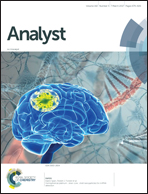A sub-picomolar assay for protein by using cubic Cu2O nanocages loaded with Au nanoparticles as robust redox probes and efficient non-enzymatic electrocatalysts†
Abstract
In this work, a simple and sensitive electrochemical aptasensor for protein (thrombin – TB used as the model) was developed by using cubic Cu2O nanocages (Cu2O-NCs) loaded with Au nanoparticles (AuNPs@Cu2O-NCs) as non-enzymatic electrocatalysts and robust redox probes. Through the specific sandwich-type reaction between TB and TB aptamers (TBA), the formed AuNPs@Cu2O-NCs bound with NH2-TBA were captured onto the electrode surface modified with SH-TBA. Based on the inherent redox activity of AuNPs@Cu2O-NCs with cubic nanostructures, a detectable electrochemical signal was generated which was dependent on the analyte concentration. Meanwhile, AuNPs@Cu2O-NCs showed an efficient electrocatalytic capability in the reduction of H2O2, resulting in a significant enhancement of the response signal. Thus, the simplification of the proposed strategy and the improvement of analytical performances were easily achieved with a sub-picomolar sensitivity (the limit of detection was 0.066 pmol L−1). The applicability of the simple and sensitive aptasensor was successfully demonstrated by assaying TB in human serum samples. This non-enzymatic detection platform would be potential and promising in clinical diagnostics and protein analysis techniques.



 Please wait while we load your content...
Please wait while we load your content...